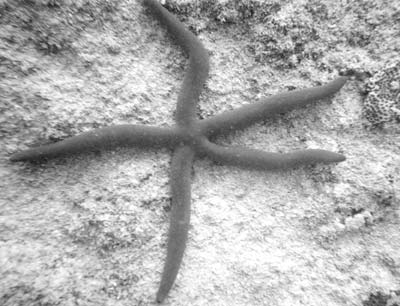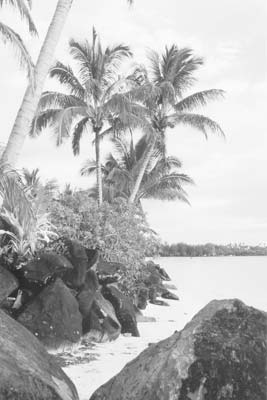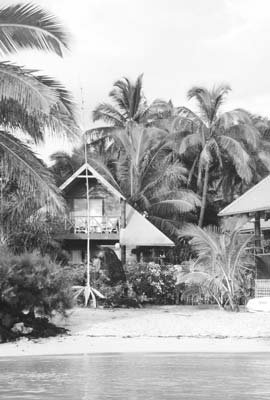A piece of paradise in the Cook Islands
by Dan Gifford, Arlington, VA (Part 6 in a series of 6)
On the island of Rarotonga, nothing can be built taller than a coconut tree. This inspired bit of zoning regulation sums up why we chose the largest of the Cook Islands over better-known South Pacific destinations like Tahiti or Fiji. No highrise hotels, no megaresorts, no way to accommodate hoards of people.
We owed our stop here to an acquaintance of mine, a remarkable woman named Diana Lockwood. Diana founded Pacific Islands Institute, a company that specializes in travel to Melanesia, Micronesia and the rest of the South Pacific rim. She knew the islands of this far-flung basin through a lifetime of travel and study, and when she was diagnosed with cancer she had only one place she wanted to see again in her short time remaining: the Cook Islands. We couldn’t have asked for a more sincere endorsement than that.
A monsoon welcome
When we arrived at night for our week-long stay, the air was soggy. The pent-up rain started falling as we went to bed, and by morning a monsoon was raging outside. The rain fell in horizontal sheets, and palm trees bowed to the awesome forces of nature that whipped along outside.
We didn’t have much choice except to stay indoors and enjoy our bungalow. Sokala Villas (phone 682 29 200 or visit www.sokalavillas.com) is a tightly arranged collection of seven separate houses. The close proximity of each one to the others leaves you praying for quiet neighbors, but management doesn’t allow guests under 12, so boisterous families go elsewhere.
Our 2-story villa included a kitchenette, a swimming pool and a balcony that overlooked the lagoon a few yards from our doorstep. An air-conditioning unit had just been installed the week before — a true blessing when it started to get hot and muggy. Our lagoon-view villa with pool cost NZ$440 (near US$270).
A spectacular first look
We listened to our radios and MP3 players, read books and caught up on local news in the daily flier (lead story, “Miss South Pacific Parade Postponed Due to Rain”). We got to know our house gecko with his noisy clicks and whirs that sounded like a windup toy. Most importantly, we decompressed after six weeks on the go and allowed the slower pace of life to seep into our bones.
When the rain abated, kissing us farewell with a land-to-land rainbow, we emerged like crabs from our holes, blinking into the sun. In the light of day, without curtains of water obscuring our view, we discovered our setup was indeed spectacular.
Muri Lagoon on Rarotonga’s southeast corner looks like God created a giant kiddie pool. The water is warm, shallow and clear, filled with colorful fish and dotted with four little islandettes crowned with palm trees.
From the beach (of course, white sand and perfect) we looked out onto the horizon to see the angry ocean crashing against the outer reef, trying to break through into our protected paradise and spoil the fun. Instead, waves would knock themselves silly on the rocks, sending up plumes dozens of feet high that always reminded me of those dancing fountains outside the Bellagio in Vegas. Even minus the music, it was still quite a show.
Underwater adventure
It didn’t take long for us to start mapping the lagoon’s submerged world through snorkeling, a pastime we pursued with single-minded determination. Wearing reef walkers with protected soles, we had to wade out halfway through the lagoon before it got deep enough to switch over to floating and swimming. Often we would just stand in place, bend over with our masks and peek like voyeurs through a keyhole at the aquatic life below.
One of the motus, or little islands, was classic South Pacific — volcanic black rock with a flattop of palm trees. Taakoka, as it was named, was where we found the best snorkeling in Muri Lagoon. We settled into a groove of swimming between boulders of coral and then coming back to shallow waters for a rest.
There were currents within this giant natural aquarium, and often we would wade to the westernmost point of the motu, swim out until we felt the gentle tug of the flow heading east and catch a free ride. Lest we go too far out, a few strokes toward land would redeposit us in shallow waters. Running, splashing back the way we came, we’d return to our starting point and begin the whole carnival loop-de-loop over again.
Glimpses of life under the sea were what kept us returning day after day. I remember going to a pet store as a kid and always being disappointed that the really cool fish required saltwater tanks. My freshwater collection inevitably looked dull after such visits. But snorkeling in the Cooks was like having all those cool fish to myself: blue damsels, butterfly fish, Moorish idols and angelfish.
We also saw several of the Cooks’ famous cobalt-blue sea stars. Some would nestle in rocks for protection, but others would sprawl out on the lagoon floor as if to say, “Look at me. I’m beautiful and I know it.”
But the most fun, both for name and for appearance, was the Picasso triggerfish. With its cacophony of yellows and blues, stripes and dots, we wondered what this fish was called before the artist’s time because today’s name is so apropos.
Exploring on land
When not frolicking in the water we stayed close to home, keeping our world largely confined to places we could walk. We were able to cook for the first time on our around-the-world adventure, so we dined on provisions gathered from the convenience store down the road. In many places, that would mean a diet of franks and beans plus an occasional slurpee, but we were able to conjure up dinners of chicken ravioli tossed with prosciutto, and shrimp with peanut sauce over rice.
Occasionally, we would bring carryout home from That’s Pasta (www.thatspasta.com), a labor-of-love restaurant run by a transplanted Milanese couple. Four kinds of homemade pasta, four kinds of homemade sauce and the freedom to mix and match however we wished. Although the menu lacked for variety, the results were always delicate and tasty. Entrées ranged from NZ$13.50 to NZ$18.50 (US$8.25-$11.25).
Going into town meant riding the bus (one bus goes clockwise around the island, the other counterclockwise) to Avarua, a largely unattractive collection of basic necessities — pharmacy, grocery store, post office with Internet and a ponderous assortment of shops selling black pearls. But the ride offers a great excuse to see the island’s topography.
From the tiny strip of beach that runs the circumference of the island, the landscape quickly dissolves into a dizzying array of valleys and sheer cliffs, all covered by a seemingly impenetrable layer of lush tropical forest.
At night we would resume our rainy-day pleasures, curling up with a book or listening to the world on our shortwave radio. Sometimes we’d hear our gecko in the rafters scolding us for cleaning the dishes so well. The waves continued their assault on the outer reef, and the palms rustled in the breeze. It was our slice of the quiet life in the South Pacific.
I think Diana would have approved.




